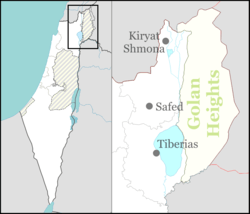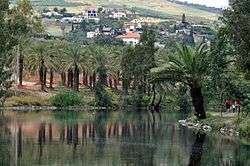Kvutzat Kinneret
| Kvutzat Kinneret | |
|---|---|
 | |
 Kvutzat Kinneret | |
| Coordinates: 32°42′48.24″N 35°33′45″E / 32.7134000°N 35.56250°ECoordinates: 32°42′48.24″N 35°33′45″E / 32.7134000°N 35.56250°E | |
| District | Northern |
| Council | Emek HaYarden |
| Affiliation | Kibbutz Movement |
| Founded | 1908 |
| Population (2015)[1] | 685 |
Kvutzat Kinneret (Hebrew: קְבוּצַת כִּנֶּרֶת) (also Kibbutz Kinneret) is a kibbutz in northern Israel founded in 1913. Located to the southwest of the Sea of Galilee near Tiberias and next to Moshavat Kinneret, it falls under the jurisdiction of Emek HaYarden Regional Council. In 2015 it had a population of 685.
Etymology

The name Kinneret derives from an ancient Canaanite town close to the northern end of the lake's western shore.[2] According to the Hebrew Bible, the town of Kinneret was part of the allotment of the tribe of Naphtali (Joshua 19:35). The site of the modern kibbutz was probably also part of Naphtali, or (depending on interpretation) of Issachar or Zebulun. In the Bible, the Sea of Galilee is called Yam Kinneret, lit. Sea of Kinneret.
History
Kvutzat Kinneret, like Degania Alef, evolved from the agricultural training farm founded in 1908 known as Havat Kinneret (Kinneret Farm) or Hatzer Kinneret (Kinneret Courtyard). The kvutza, or 'group', was established within the Kinneret Farm in 1913 by a small number of idealistic pioneers who believed in the communal way of life and sharing all material goods. In 1929, the group settled at their current, permanent location higher up the hill. Kinneret is the only kibbutz west of the Jordan River that settled on the rocky slopes rather than the valley.[3] Beekeeping and the sale of honey were among the earliest economic branches.[4] The early settlers planted date palms but found that the dates were of inferior quality. In the 1930s,[5] 75,000 high-quality date palm saplings were smuggled out of Iraq aboard a ship supposedly heading for Italy. The cargo was transported across the Shatt al-Arab waterway to the Iranian side, and from there through the Suez Canal to Cyprus, where it was put on board a ship to Haifa.[6]
Kinneret Cemetery
To the east of the kibbutz, across the road from the restored Kinneret Farm, is the historic Kinneret Cemetery where many pioneers and leaders of the Labour movement are buried,[7] among them Berl Katznelson, Nachman Syrkin, Rachel Bluwstein, Ber Borochov, Moses Hess, Avraham Herzfeld and Shmuel Stoller. The first person buried in the cemetery was Menachem Shmulevich-Shmueli in 1911.
"Motor House" pumping station
The Motor House (Beit HaMotor) was constructed in 1910 to house a water pump used to draw water for irrigation;[8] it was the first pumping station in what would become modern Israel.[9] The Motor House is located at the base of the hill, among Kinneret's orchards and fields, across the road from the Yardenit baptismal site.
Notable residents
- Shaul Avigur (1899–1978), one of the founders of the Israeli Intelligence Community
- Liel Kolet (b. 1989), pop singer
- Shlomo Lavi (1882-1963), Zionist activist and politician (before moving to Ein Harod)
- Naomi Shemer (1930–2004), songwriter, the "First Lady of Israeli song and poetry"
- Shmuel Stoller (1898–1977), agronomist, co-founder of the kibbutz, Israel Prize laureate
See also
- Second Aliyah, 1904-1914 Jewish emigration wave to the Land of Israel
- Yardenit, Christian baptism site established by Kvutzat Kinneret on the River Jordan
References
- ↑ "List of localities, in Alphabetical order" (PDF). Israel Central Bureau of Statistics. Retrieved 16 October 2016.
- ↑ "Kinneret Regional Project".
- ↑ Kinneret Kibbutz Celebrates Centennial and a History of 'Sacred Stubbornness'
- ↑ For All Tastes. Haaretz.
- ↑ Ben-Zion Israeli's travels to the East
- ↑ Backyard history, Jerusalem Post
- ↑ Sanctity of Time and Space in Tradition and Modernity, eds. Alberdina Houtman, M. J. H. M. Poorthuis, Joshua J. Schwartz
- ↑ Immerse yourself in purity on the Jordan River shore
- ↑ Aviva Bar-Am, Off the beaten track: Yardenit walk, Jerusalem Post, 6.9.2007